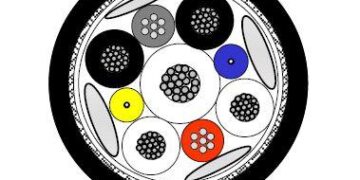A casket is a specially designed rectangular box with four sides used for the containment and burial of deceased persons, whereas a coffin is traditionally an anthropoid-shaped container with six sides. RichLegg / Getty Images
Caskets vs. coffins: How much do these burial containers differ? We know that they appear in the television dramas we watch, the horror movies we compulsively consume and the dreams that play across our brains at night. Sometimes, we even encounter them, in their tangible form, in our own lives.
But despite coffins ruling natural burials all over the globe, we often conflate these containers and their casket counterparts
In this article, we’ll size these natural burial containers up and learn about their differences, similarities and relationships to the undead in pop culture.
What Is a Coffin?
A coffin is traditionally an anthropoid-shaped container with six sides. The container is wider at the shoulders and tapering toward the feet, with a lid used for containing and displaying a deceased person’s body during funeral ceremonies, as well as for burial or cremation.
Often crafted from wood, coffins vary in style, material and design, reflecting diverse cultural, religious and personal preferences.
Modern coffins may also include materials like metals, biodegradable substances or luxurious fabrics. Some feature a hinged lid for ease of access. While the classic design is tapered, some coffins may have more elaborate decorations or slight variations in shape to suit specific aesthetic or cultural needs.
Coffin Furniture
Then there’s the coffin furniture, which refers to the decorative and functional hardware used on coffins, enhancing their appearance and aiding in their handling. This includes handles, ornaments, nameplates and interior lining.
Chosen for both aesthetic and symbolic purposes, coffin furniture varies in style and complexity, reflecting cultural and personal preferences in memorial practices.
What Is a Casket?
A casket is a specially designed rectangular box with four sides used for the containment and burial or cremation of deceased persons. Typically, it comes with a hinged lid that can be opened for viewings or closed for the burial or cremation process.
Caskets are commonly constructed from various materials such as wood, metal or even biodegradable materials, depending on personal, cultural or religious preferences. The interior of a casket is often lined with soft, plush fabric like satin or velvet, providing a respectful and dignified appearance.
Caskets may also feature ornate designs, handles for carrying and sometimes personalized embellishments that reflect the personality or wishes of the deceased or their family.
Like coffins, caskets serve as a focal point during funeral services and as the final resting enclosure for the deceased.
Differences Between a Coffin and a Casket
In North America, you’ll hear people use the terms interchangeably, but there are key differences between caskets and coffins.
Shape: Coffins have a distinctive shape, wider at the shoulders and tapering toward the feet, resembling the human body’s form. This design is traditional and often seen in historical contexts. Caskets, on the other hand, are rectangular and box-like, reflecting a more contemporary design.Design and materials: Coffins are usually simpler in design, often made of plain wood. Conversely, caskets tend to be more elaborate, featuring higher-quality materials and lined with luxurious fabrics like satin or velvet. Because of their durability, a metal casket is a popular option at funeral homes.Lid style: Coffins often come with a split-lid design, allowing for an open-casket viewing of the upper part of the deceased. Many caskets have a hinged single lid that covers the entire body, although some may feature a two-part lid that can be opened separately for viewings.Cultural usage: The use of coffins is more prevalent in European funerary traditions, where the tapered design is still widely used. In contrast, caskets are more commonly used in North America, where they are a standard part of modern funeral practices.Cost: Another primary difference between the two is price. The modern casket — often more elaborately designed and constructed with higher-end materials — generally costs more than the simpler, tapered design of coffins.
Funeral Home Lingo
Funeral professionals tend to avoid the word “coffin” for its perceived morbid and depressing air, which could put off potential customers. They have some other euphemisms, too [source: Mitford].
“Display area” instead of “casket room””Casket coach” instead of “hearse””Interment space” instead of “grave””Opening the interment space” instead of “digging the grave”
No matter what your local funeral director calls them, coffins can be unsettling. As a result, many cultures employ a pall during funeral ceremonies, which is a heavy cloth that is placed over the coffin.
Now that you can speak the lingo, let’s find out why picking the wrong coffin might have explosive consequences.
Material Matters
In mid-20th century America, metal caskets, which were actually cheaper to produce in large quantities than high-quality wooden coffins and thus offered greater profit margins, began to sell at significantly higher rates due to their modern appearance.
So great was the influence of funeral directors and coffin salespeople that customers began to purchase metal coffins for cremations, which meant the coffin would have to be disposed of separately.
Quirks and Innovations in Coffin Anatomy
A coffin’s basic purpose is to create a barrier around a corpse. But what happens when that’s just not enough? Over the years, the funeral industry has developed some specialized coffins to address a variety of needs and concerns.
One example is the protective coffin, which the American funeral industry has promoted heavily because it features a rubber gasket to provide a more durable seal against earth and elements. Some designs have employed an impermeable seal, which might seem like an attractive option initially.
After all, if you’re burying a loved one, it’s natural to prefer the most secure receptacle available.
However, as a body decays, it produces methane gas — which, if not allowed to leak out, builds up within the coffin and can literally cause it to explode. Since no one wants that, the industry developed burping coffins, which are protective structures that rely on a permeable seal to protect the body while allowing gas to escape.
Although these coffins do add a degree of protection from decay, it’s now illegal for funeral providers to claim that these models will preserve the body indefinitely.
Grave-robbing Medical Students
These protective caskets wouldn’t have been enough to protect a body from medical students during the early 19th century, though. During this so-called body-snatching period, thieves broke into graves to retrieve corpses for medical education and research.
In response, the funeral industry developed more heavy-duty protective measures. Instead of just a coffin, bodies would often be interred in thick-walled vaults, potentially equipped with several locks and staffed by guards.
Additionally, a mortsafe, a type of iron cage placed over a vault, might have been secured in concrete over the grave. A locked gate would allow loved ones access to the grave.
Not enough money for the more high-tech solutions? Heavy wooden planks or metal slabs placed over the coffin proved difficult for unwanted visitors to remove. Alternatively, stones filling the grave instead of dirt would cause a ruckus if disturbed, drawing attention to would-be body snatchers during the act.
Now let’s take a look at the long relationship between coffins and vampires in pop culture.
Coffins and Vampires
Unless you work in the funeral industry, your practical interactions with coffins are, we hope, few and far between. Instead, most of us are familiar with coffins through fiction, from campfire tales to mummy and vampire movies.
Many myths claim that vampires sleep in coffins during the day to avoid sunlight. When a suspected vampire is dug up, the body is said to look lifelike, lacking the stiffness and bluish pallor of a corpse. In addition, the coffin may also be filled with blood.
Perhaps the most widely known vampire story is that of Count Dracula, the title character in Bram Stoker’s 1897 novel, “Dracula.” Stoker’s “Dracula” and the myths that inspired it spawned hundreds, if not thousands, of other vampire stories, from the silent film horror film “Nosferatu” and Anne Rice’s dramatic “Vampire Chronicles” novels to the comedic “Buffy the Vampire Slayer” film and TV series and Stephenie Meyer’s teen-romance franchise, “Twilight.”
As with most myths, coffin-based folklore has many of its roots in truth. One reason that these various coffin myths are so permanent — and potent — is that when it comes right down to it, the idea of being buried is just plain scary. And if being buried in general is that bad, being buried alive must be far worse.
This article was updated in conjunction with AI technology, then fact-checked and edited by a HowStuffWorks editor.
Lots More Information
Related Articles
Sources
American Psychiatric Association. “Phobias.” (Sept. 24, 2011) http://www.healthyminds.org/Main-Topic/Phobias.aspxAustralian Museum. “Safety Coffins.” (Oct. 12, 2011) http://australianmuseum.net.au/Safety-coffinsBBC. “In Pictures: Ghana’s Amazing Coffins.” Dec. 6, 2010. (Sept. 22, 2011) http://www.bbc.co.uk/news/world-africa-11879532China Internet Information Center. “Mysterious Hanging Coffins of the Bo.” 2011. (2 October 2011) http://www.china.org.cn/english/culture/55407.htmChinese Ministry of Culture. “Chinese Funeral Customs.” 2003 (Oct. 2, 2011) http://www.chinaculture.org/gb/en_chinaway/2004-03/03/content_46092.htmChina Travel. “The Hanging Coffins on the Cliffs in the Three Gorges.” 1998 (Oct. 4, 2011) http://www.chinatravel.com/focus/yangtze-river/hanging-coffin.htmColumbia Encyclopedia, The. “Coffin.” 1999. (Oct. 6, 2011) http://www.encyclopedia.com/topic/coffin.aspx#1Dictionary.com. “Taphophobia.” (Sept. 24, 2011) http://dictionary.reference.com/browse/taphophobiaEllison, Taylor Ray. “The Coffin Texts.” Tour Egypt. (Sept. 25, 2011) http://www.touregypt.net/featurestories/coffintext.htmEncyclopedia of Occultism and Parapsychology. “Vampire.” 2001. (Oct. 7, 2011) http://www.encyclopedia.com/topic/Vampires.aspxEncyclopedia of World Biography. “Bram Stoker Biography.” (Oct. 6, 2011) http://www.notablebiographies.com/Sc-St/Stoker-Bram.htmlFuneral Source, The. “Funeral Related Supplies.” (Sept. 23, 2011) http://thefuneralsource.org/tfs004.htmlHarper, Douglas. “Coffin.” Online Etymology Dictionary. (Sept. 22, 2011) http://www.etymonline.com/index.php?allowed_in_frame=0&search=coffin&searchmode=noneHistory.com. “Tutankhamen.” (Oct. 8, 2011) http://www.history.com/topics/tutankhamenHolland, Michael. “The Graves of Tana Toraja.” (Oct. 17, 2011) http://asiaforvisitors.com/indonesia/sulawesi/tana-toraja/graves/index.phpInternational Encyclopedia of the Social Sciences. “Zombies.” 2008. (Oct. 8, 2011) http://www.encyclopedia.com/topic/Zombies.aspxInternet Movie Database. “70 Best Vampire Movies.” (Oct. 8, 2011) http://www.imdb.com/list/F1w6m2-kN9k/Jewish Federations of North America. “Jewish Funeral Customs: Saying Goodbye to a Loved One.” 2011 (Sept. 30, 2011) http://www.jewishfederations.org/page.aspx?id=937Merriam-Webster. “Casket.” (Sept. 23, 2011) http://www.merriam-webster.com/dictionary/casketMerriam-Webster. “Cosmography.” Oct. 7, 2011) http://www.merriam-webster.com/dictionary/cosmographyMerriam-Webster. “Coffin.” 2011. (Sept. 22, 2011) http://www.merriam-webster.com/dictionary/coffinMerriam-Webster. “Sarcophagus.” (Oct. 8, 2011) http://www.merriam-webster.com/dictionary/sarcophagusMitford, Jessica. “The American Way of Death Revisited.” Alfred A. Knopf. 1998.National Association of Cognitive Behavioral Therapists. “What Is CBT.” (Oct. 7, 2011) http://www.nacbt.org/whatiscbt.htmShultz, Suzanne M. “Body Snatching: The Robbing of Graves for the Education of Physicians in Early Nineteenth Century America.” McFarland. 2005.United States Public Health Service. “State Laws and Regulations Pertaining to Public Health.” U.S. Government Print Office. 1920.Williams, Brian. “Infectious Diseases in History.” 1997. (Oct. 17, 2011) http://urbanrim.org.uk/diseases.htm#CholeraWoodward, Angela. “Coffin.” How Products Are Made, Volume 4. (Oct. 2, 2011) http://www.madehow.com/Volume-4/Coffin.html
>>> Read full article>>>
Copyright for syndicated content belongs to the linked Source : How To Stuff – https://science.howstuffworks.com/science-vs-myth/afterlife/coffin.htm
































